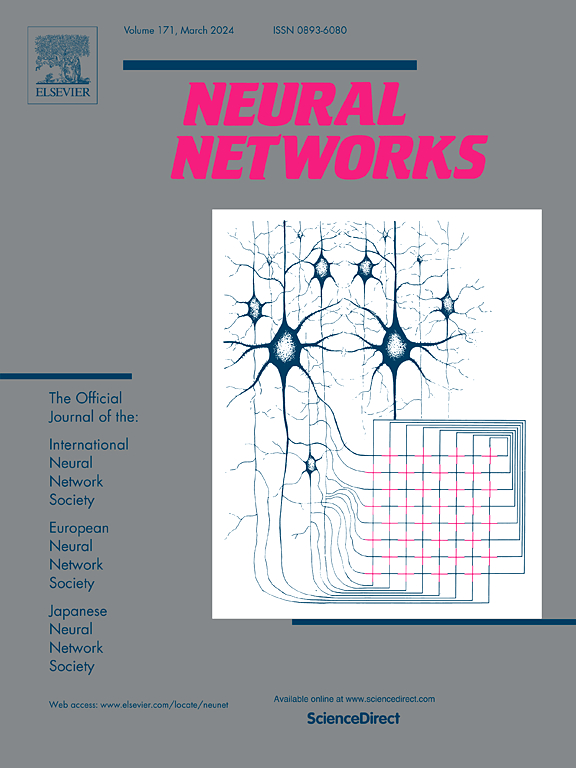基于黎曼几何的空间滤波(RSF)增强运动意象脑电分类
IF 6
1区 计算机科学
Q1 COMPUTER SCIENCE, ARTIFICIAL INTELLIGENCE
引用次数: 0
摘要
运动意象(MI)是指在没有物理执行的情况下对运动的心理模拟,它可以用脑电图(EEG)来捕捉。该领域由于其在脑机接口(BCI)应用方面的巨大潜力,特别是对身体残疾的个体,已经获得了重要的研究兴趣。然而,由于MI脑电图信号的非平稳性质、低信噪比以及对外部和生理噪声的敏感性,准确分类仍然是一个重大挑战。传统的分类方法,如公共空间模式(CSP),通常假设数据是平稳的和高斯的,这限制了它们在这些假设不成立的现实场景中的适用性。这些挑战突出了需要更强大的方法来提高MI-BCI系统的分类精度。为了解决这些问题,本研究引入了一种基于黎曼几何的空间滤波(RSF)方法,该方法将EEG信号投影到一个较低维的子空间中,最大化不同类别协方差矩阵之间的黎曼距离。通过利用EEG数据固有的几何特性,RSF增强了特征的判别能力,同时保持了对噪声的鲁棒性。RSF的性能评估结合十种常用的MI解码算法,包括CSP与线性判别分析(CSP- lda),滤波器组CSP (FBCSP),最小距离黎曼均值(MDM),切线空间映射(TSM), EEGNet, ShallowConvNet (sCNN), DeepConvNet (dCNN), FBCNet, Graph-CSPNet和lda - net,使用六个公开的MI- bci数据集。结果表明,RSF显著提高了分类精度并减少了计算时间,特别是对于具有高计算复杂度的深度学习模型。这些发现强调了RSF作为MI EEG分类的有效空间滤波方法的潜力,为开发鲁棒MI- bci系统提供了新的见解和机会。这项研究的代码可在https://github.com/PLC-TJU/RSF上获得。本文章由计算机程序翻译,如有差异,请以英文原文为准。
Enhancing motor imagery EEG classification with a Riemannian geometry-based spatial filtering (RSF) method
Motor imagery (MI) refers to the mental simulation of movements without physical execution, and it can be captured using electroencephalography (EEG). This area has garnered significant research interest due to its substantial potential in brain-computer interface (BCI) applications, especially for individuals with physical disabilities. However, accurate classification of MI EEG signals remains a major challenge due to their non-stationary nature, low signal-to-noise ratio, and sensitivity to both external and physiological noise. Traditional classification methods, such as common spatial pattern (CSP), often assume that the data is stationary and Gaussian, which limits their applicability in real-world scenarios where these assumptions do not hold. These challenges highlight the need for more robust methods to improve classification accuracy in MI-BCI systems. To address these issues, this study introduces a Riemannian geometry-based spatial filtering (RSF) method that projects EEG signals into a lower-dimensional subspace, maximizing the Riemannian distance between covariance matrices from different classes. By leveraging the inherent geometric properties of EEG data, RSF enhances the discriminative power of the features while maintaining robustness against noise. The performance of RSF was evaluated in combination with ten commonly used MI decoding algorithms, including CSP with linear discriminant analysis (CSP-LDA), Filter Bank CSP (FBCSP), Minimum Distance to Riemannian Mean (MDM), Tangent Space Mapping (TSM), EEGNet, ShallowConvNet (sCNN), DeepConvNet (dCNN), FBCNet, Graph-CSPNet, and LMDA-Net, using six publicly available MI-BCI datasets. The results demonstrate that RSF significantly improves classification accuracy and reduces computational time, particularly for deep learning models with high computational complexity. These findings underscore the potential of RSF as an effective spatial filtering approach for MI EEG classification, providing new insights and opportunities for the development of robust MI-BCI systems. The code for this research is available at https://github.com/PLC-TJU/RSF.
求助全文
通过发布文献求助,成功后即可免费获取论文全文。
去求助
来源期刊

Neural Networks
工程技术-计算机:人工智能
CiteScore
13.90
自引率
7.70%
发文量
425
审稿时长
67 days
期刊介绍:
Neural Networks is a platform that aims to foster an international community of scholars and practitioners interested in neural networks, deep learning, and other approaches to artificial intelligence and machine learning. Our journal invites submissions covering various aspects of neural networks research, from computational neuroscience and cognitive modeling to mathematical analyses and engineering applications. By providing a forum for interdisciplinary discussions between biology and technology, we aim to encourage the development of biologically-inspired artificial intelligence.
 求助内容:
求助内容: 应助结果提醒方式:
应助结果提醒方式:


